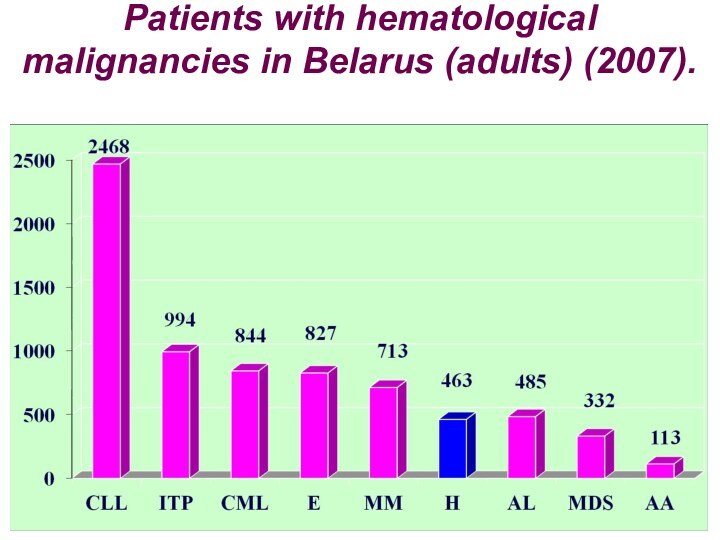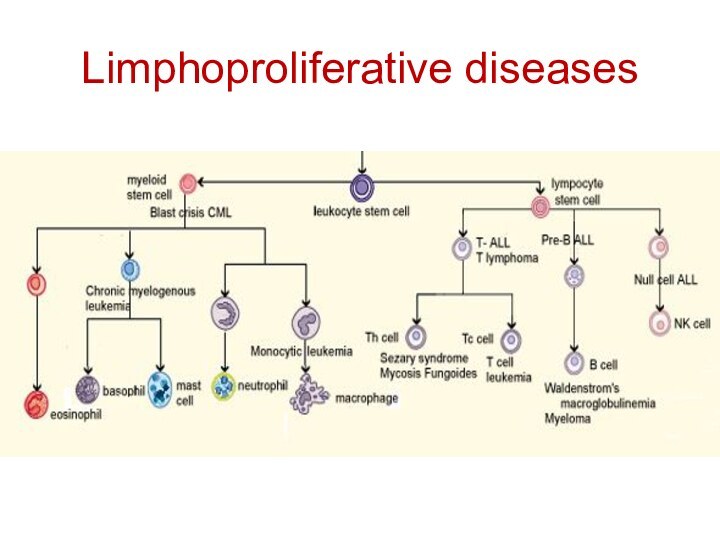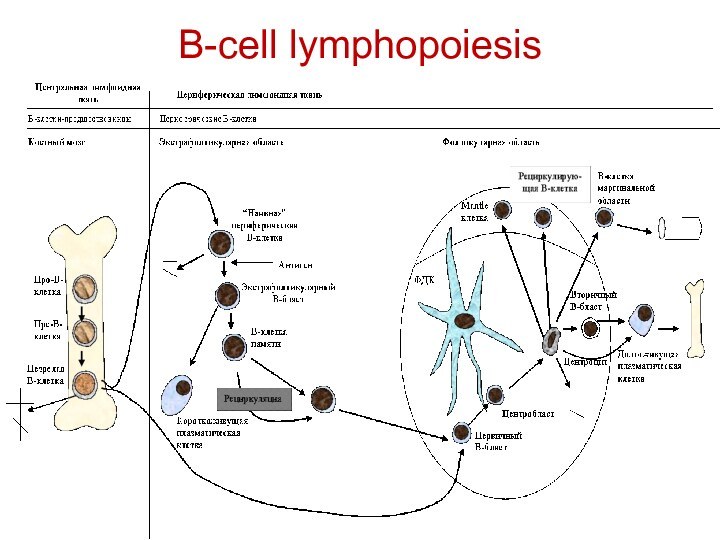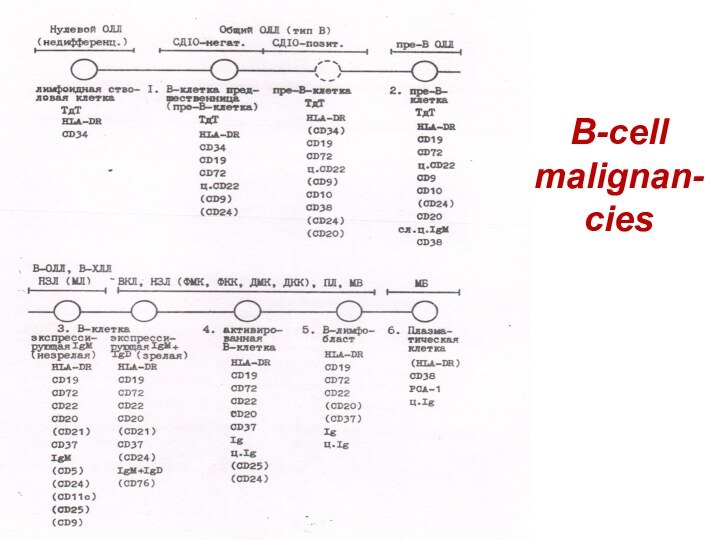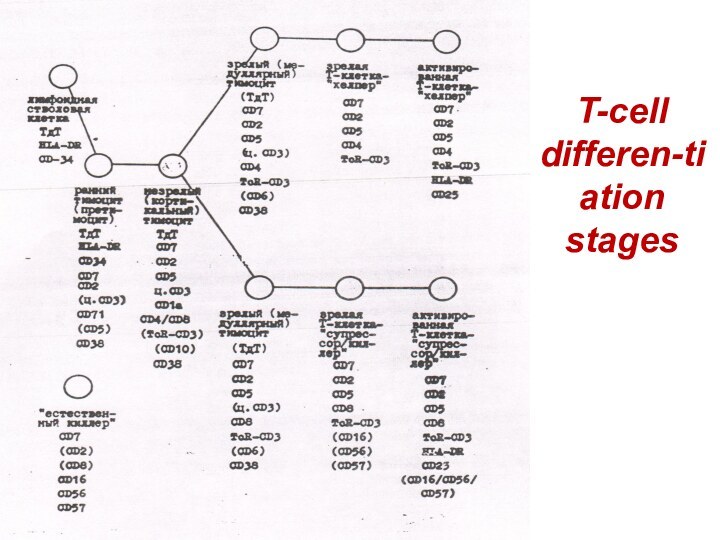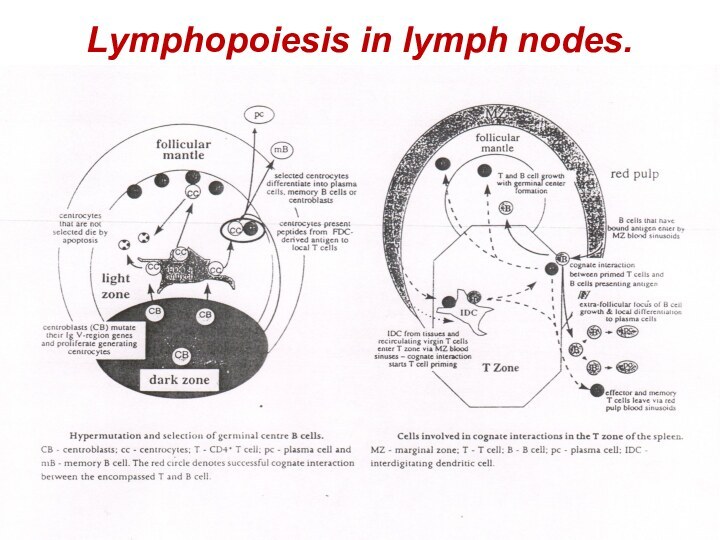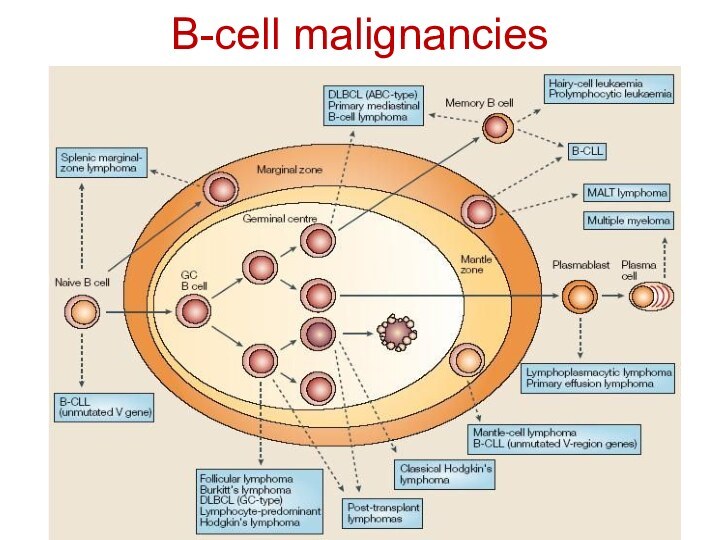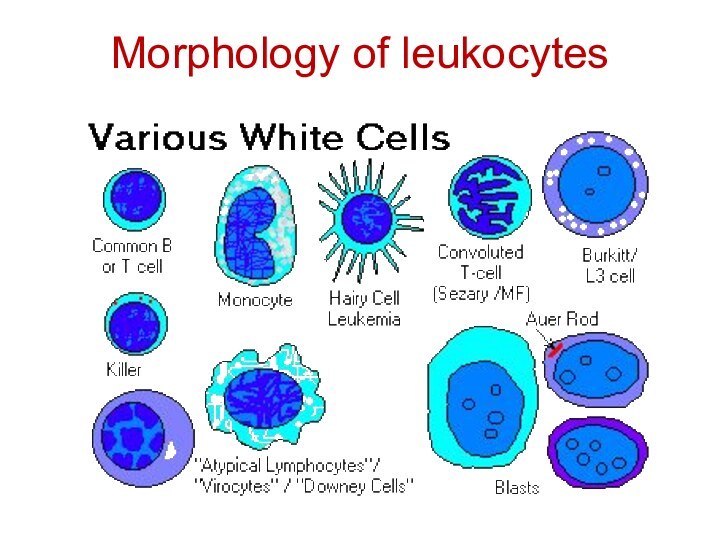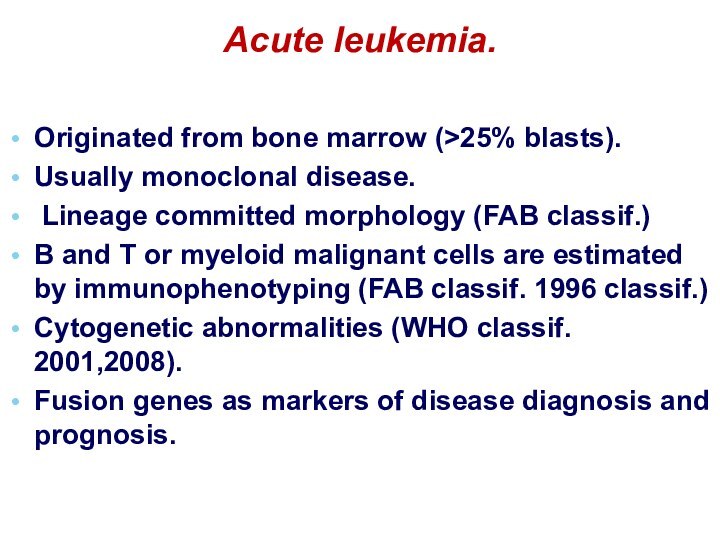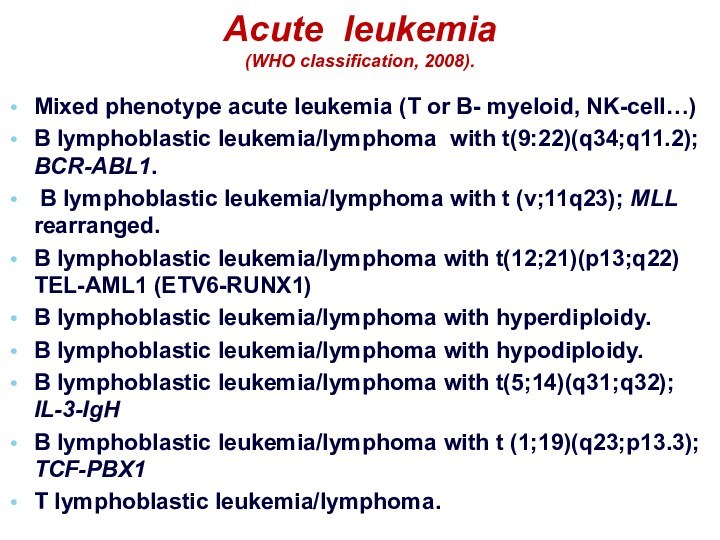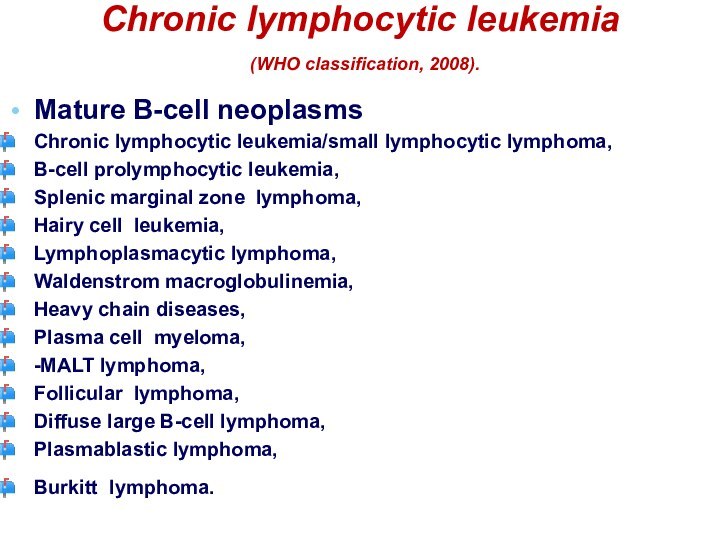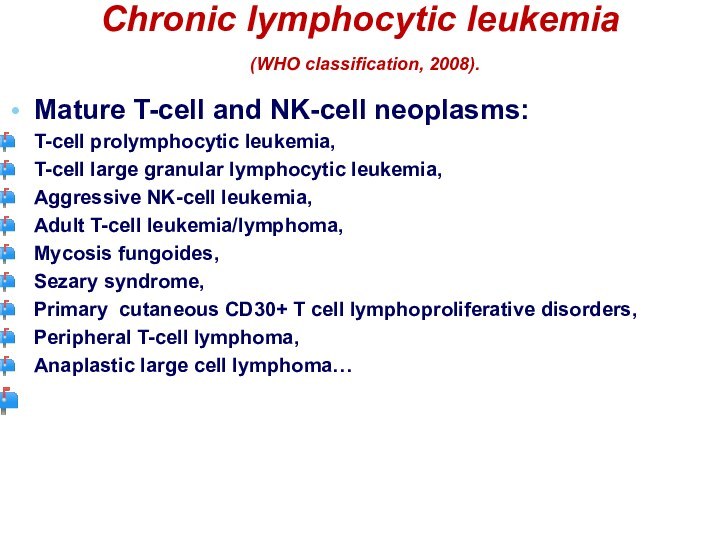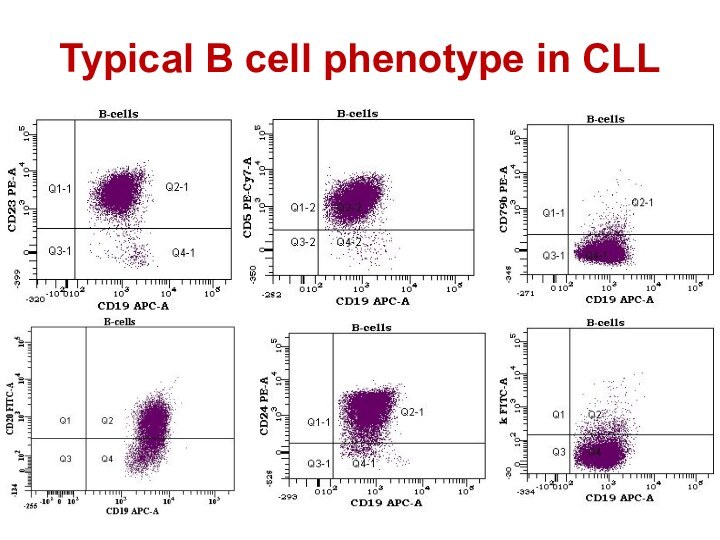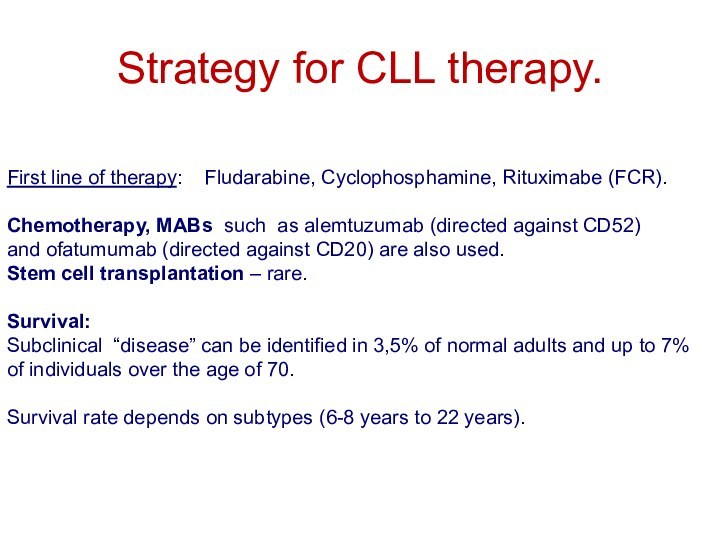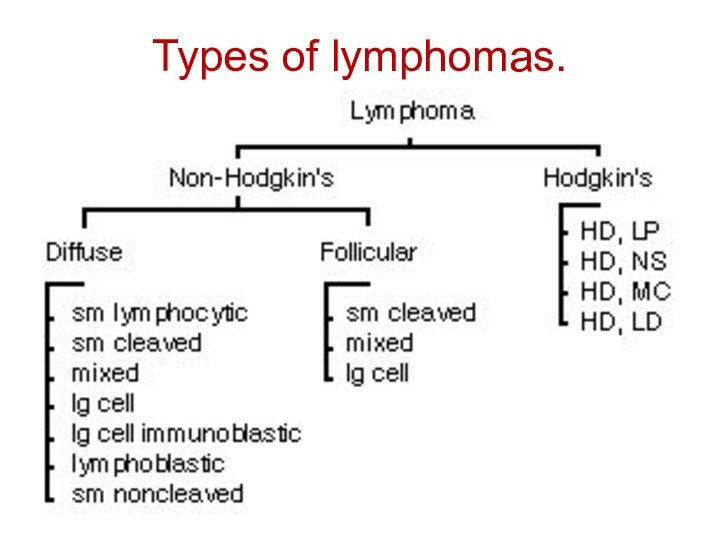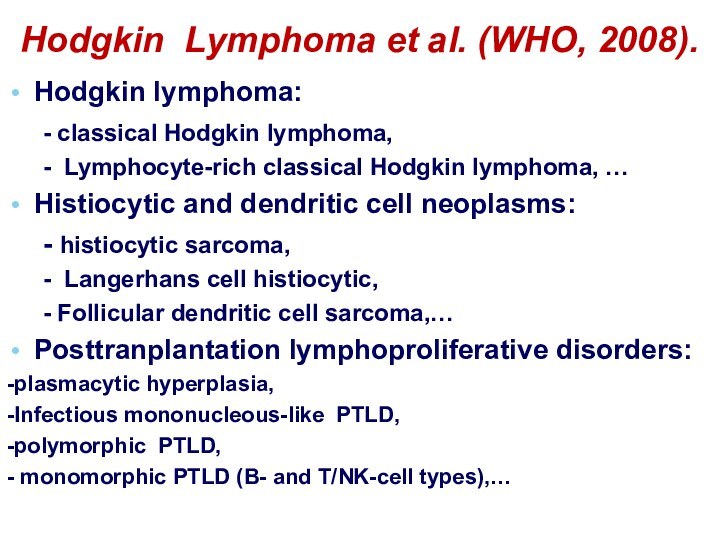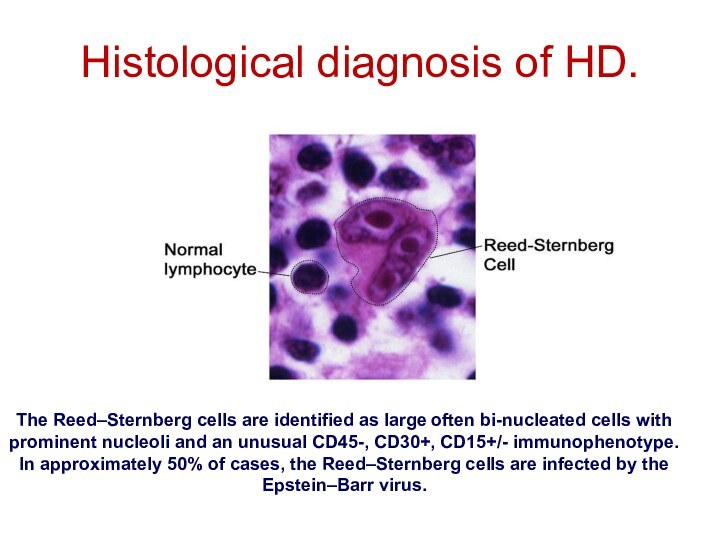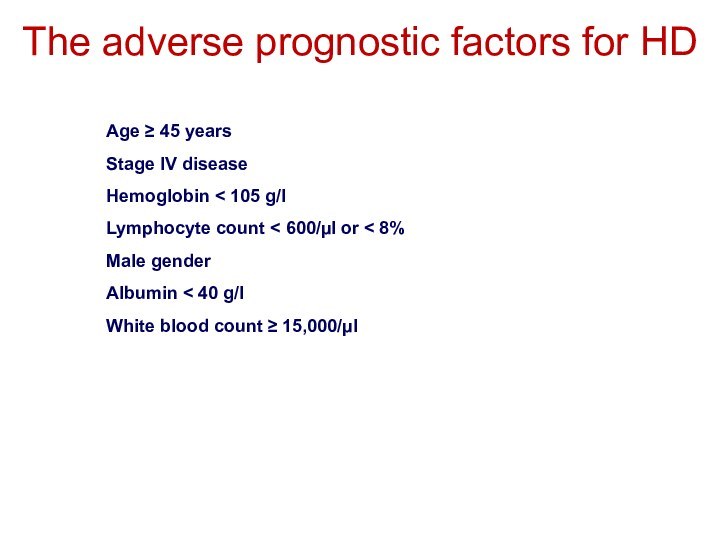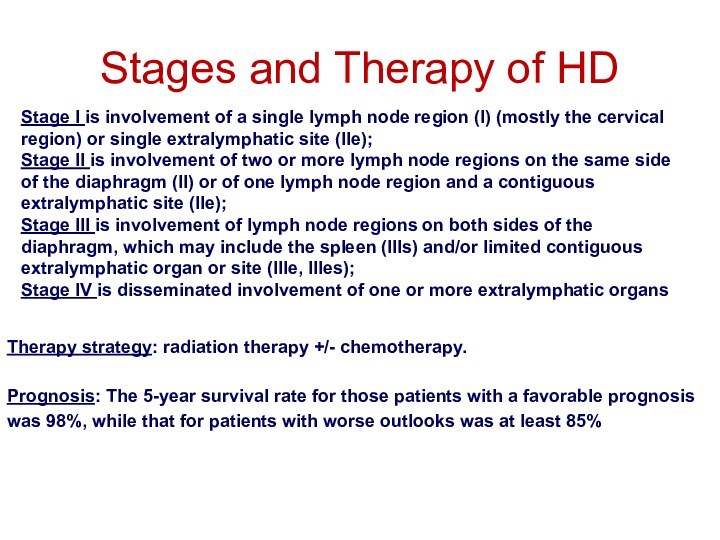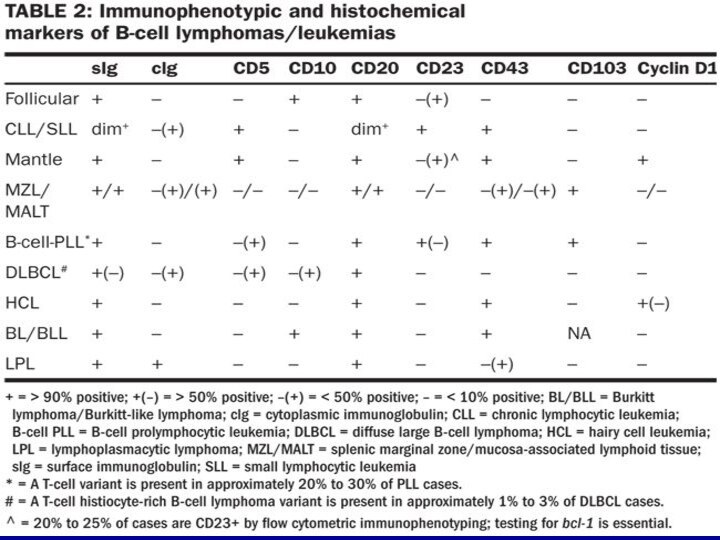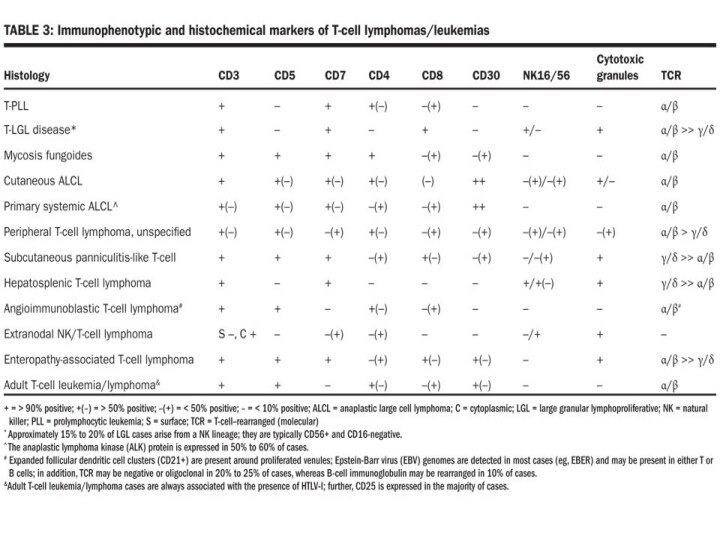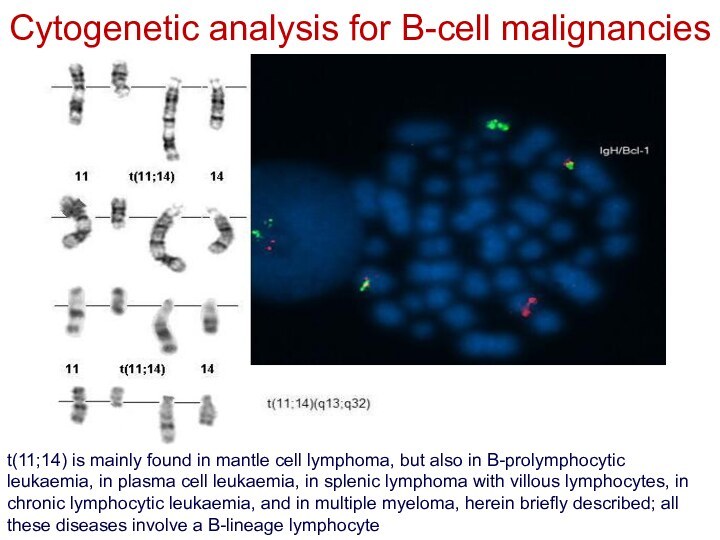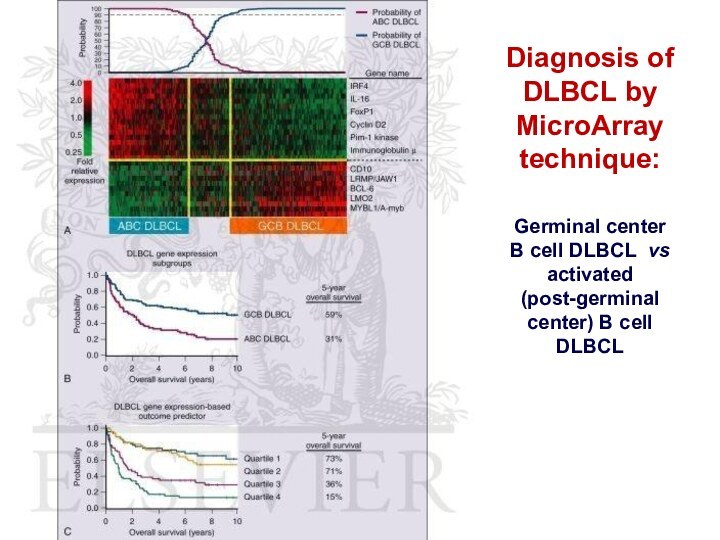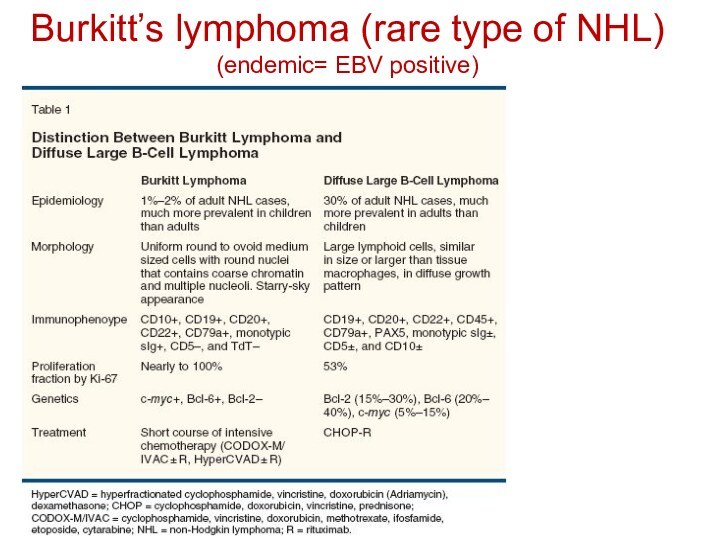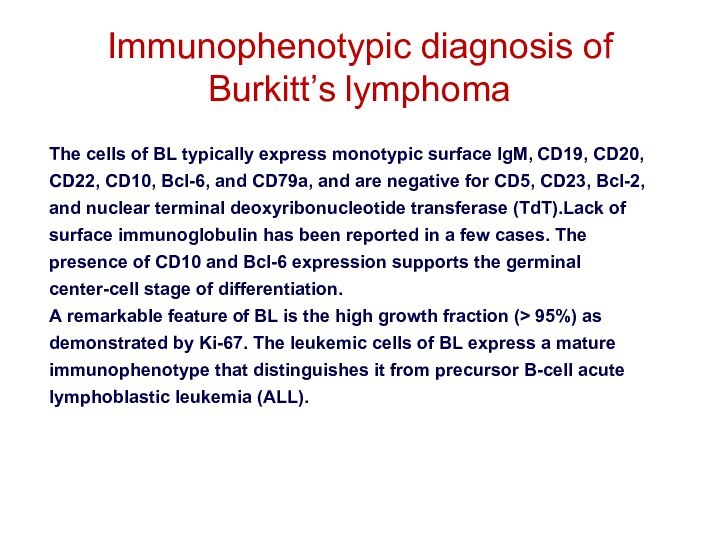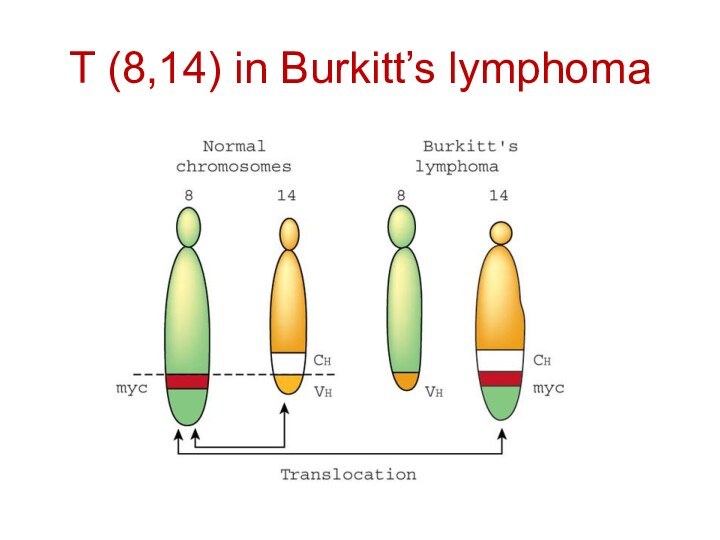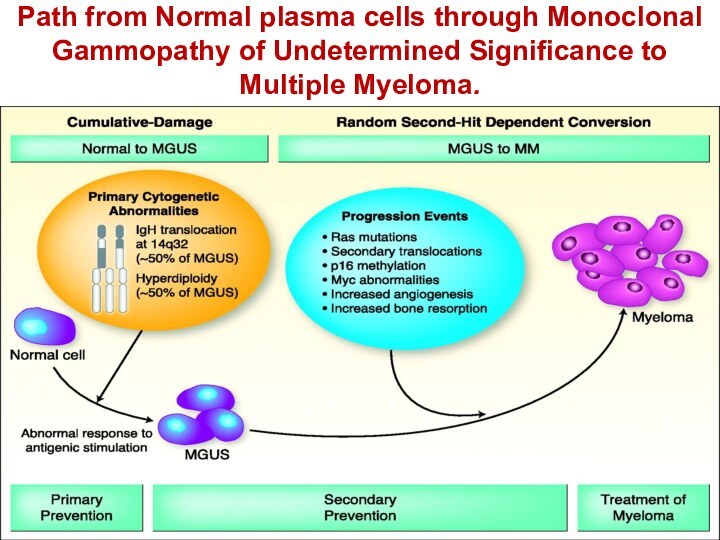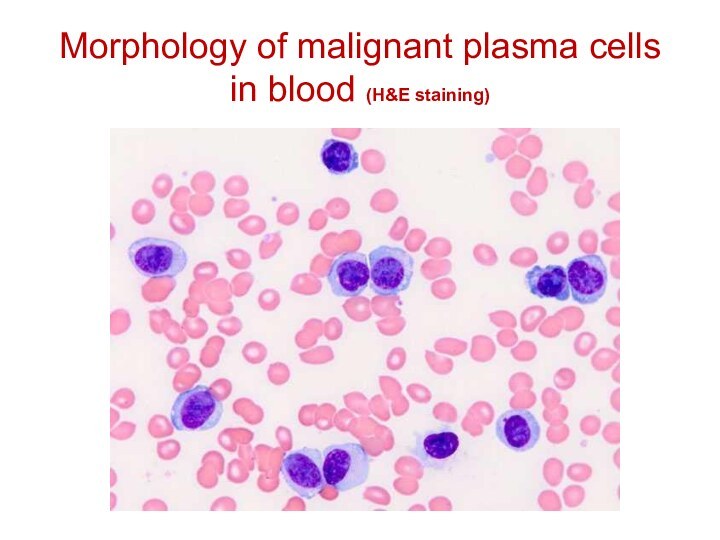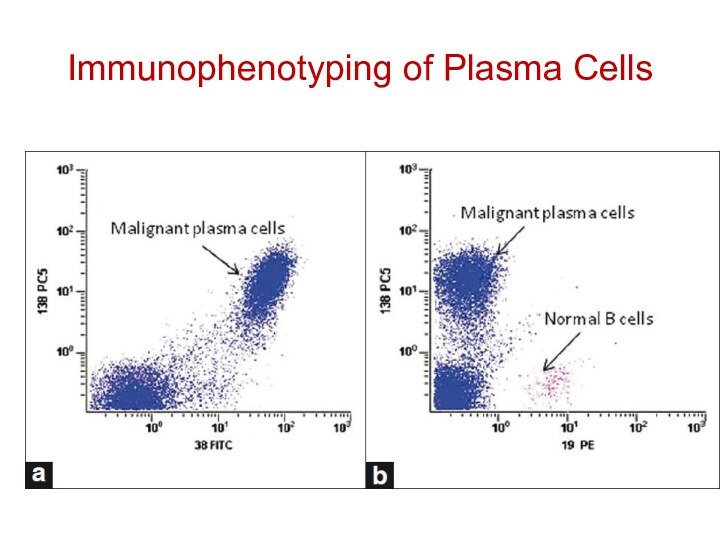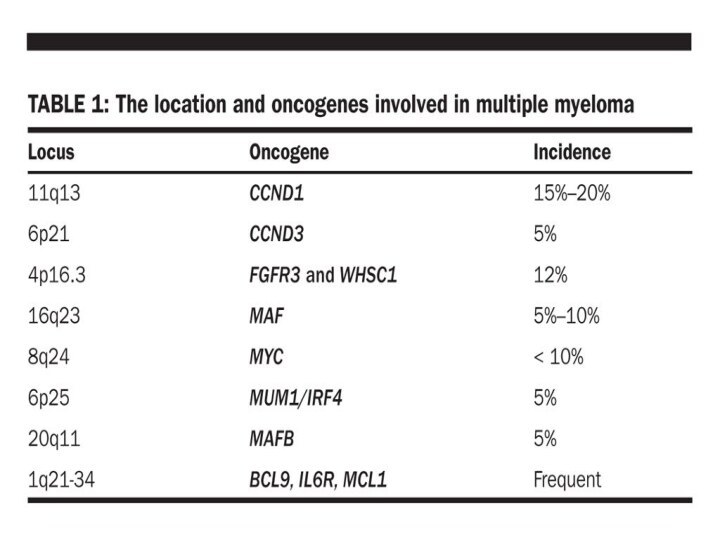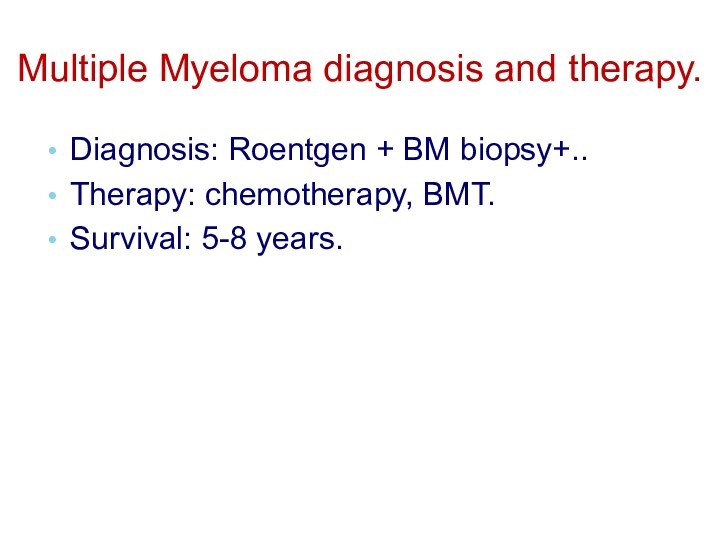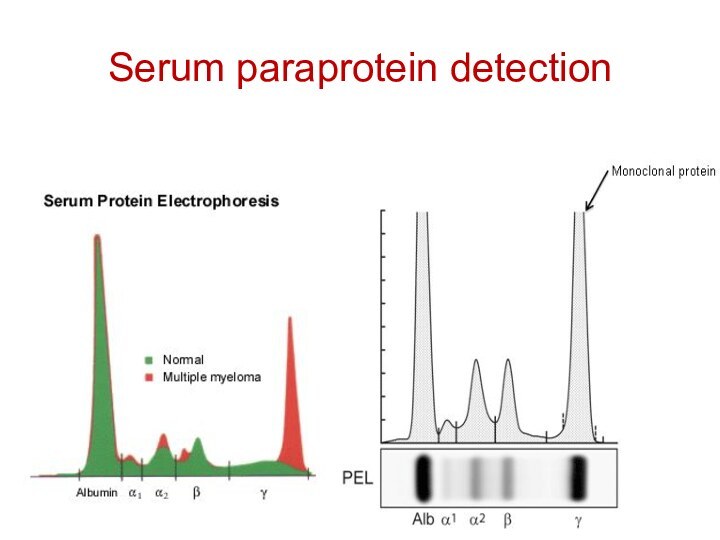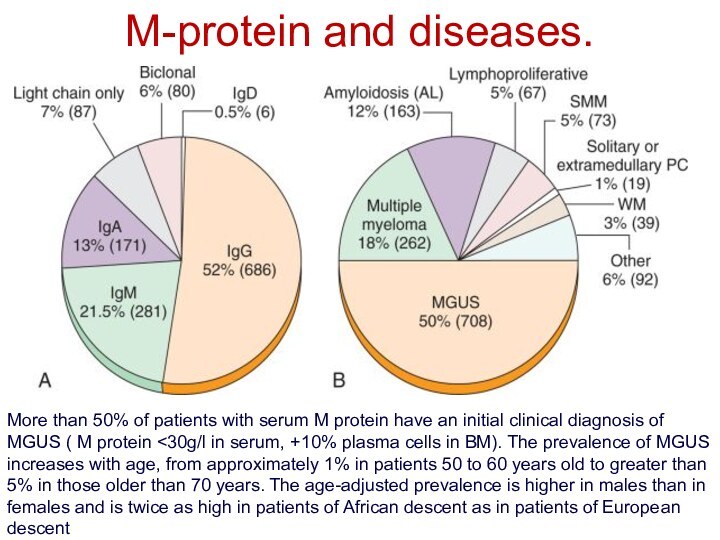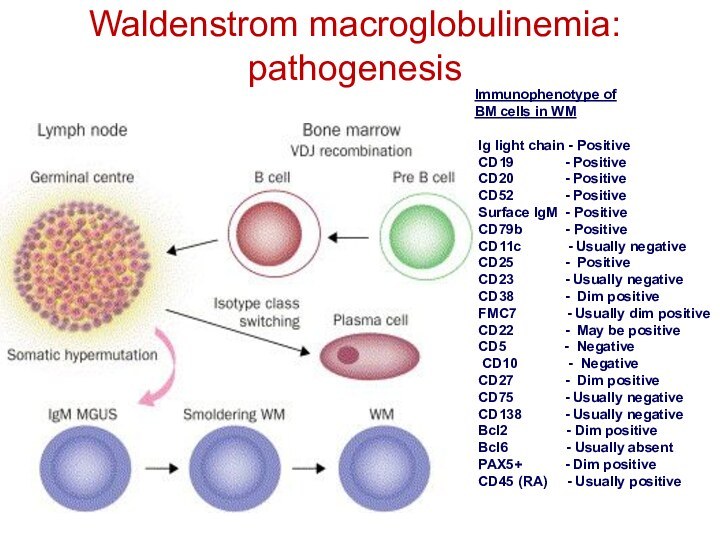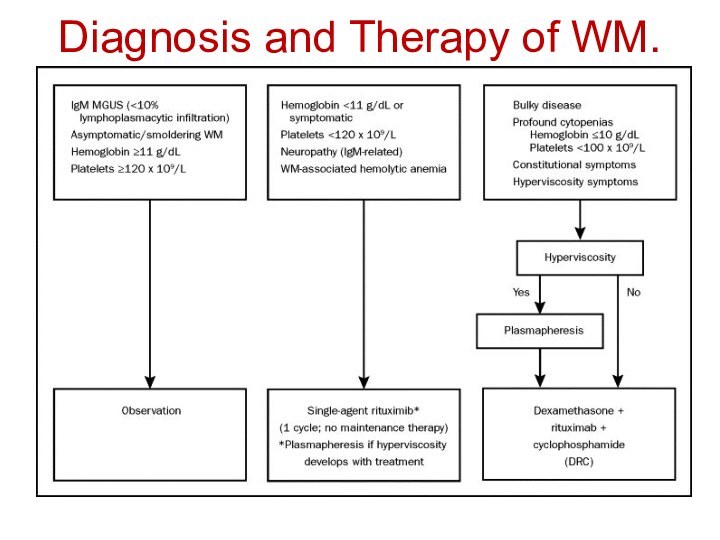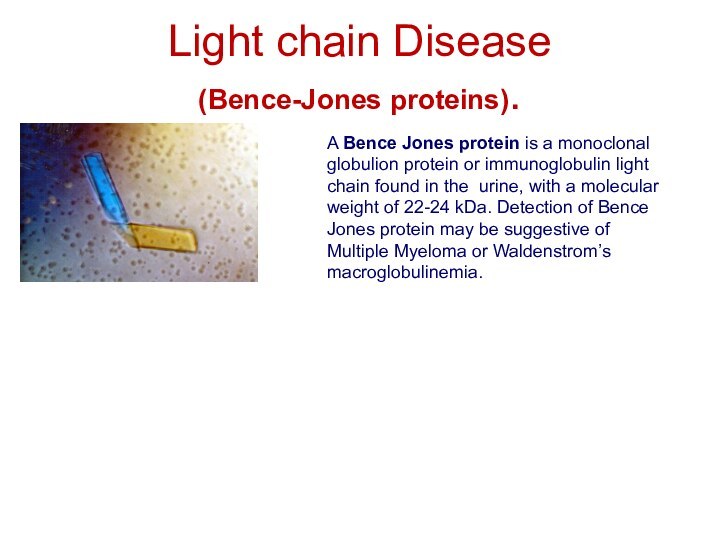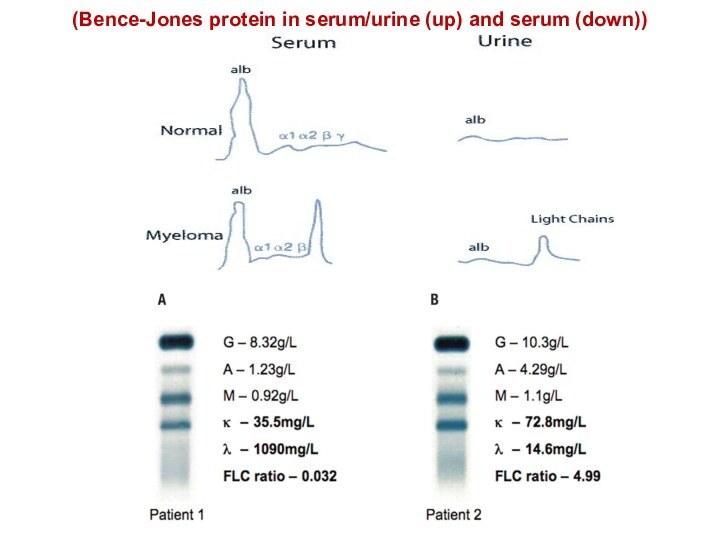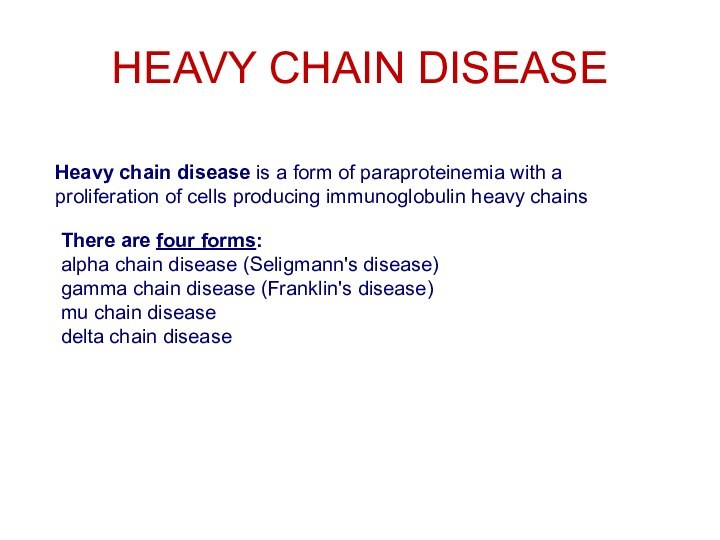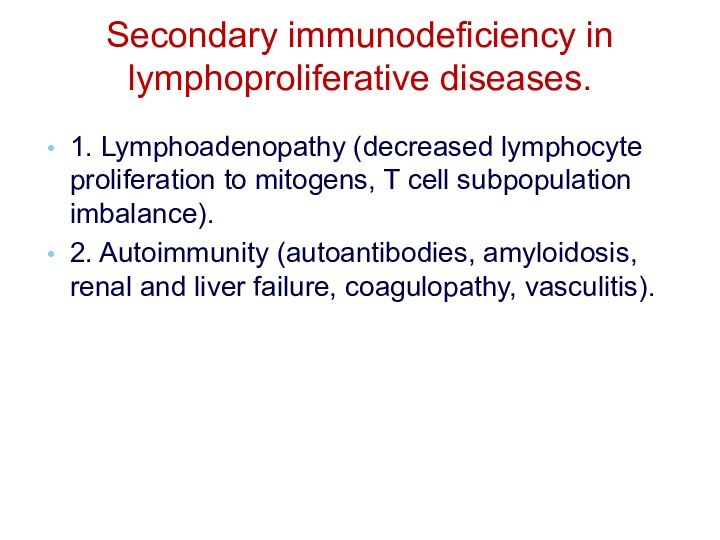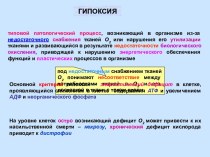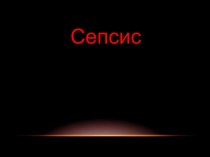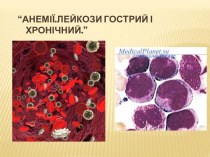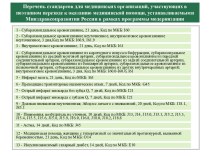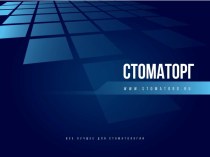Слайд 2
Patients with hematological malignancies in Belarus (adults) (2007).
Слайд 3
Limphoproliferative diseases
Слайд 6
T-cell differen-tiation stages
Слайд 7
Lymphopoiesis in lymph nodes.
Слайд 10
Acute leukemia.
Originated from bone marrow (>25% blasts).
Usually monoclonal
disease.
Lineage committed morphology (FAB classif.)
B and T
or myeloid malignant cells are estimated by immunophenotyping (FAB classif. 1996 classif.)
Cytogenetic abnormalities (WHO classif. 2001,2008).
Fusion genes as markers of disease diagnosis and prognosis.
Слайд 11
Acute leukemia
(WHO classification, 2008).
Mixed phenotype acute leukemia
(T or B- myeloid, NK-cell…)
B lymphoblastic leukemia/lymphoma with t(9:22)(q34;q11.2);
BCR-ABL1.
B lymphoblastic leukemia/lymphoma with t (v;11q23); MLL rearranged.
B lymphoblastic leukemia/lymphoma with t(12;21)(p13;q22) TEL-AML1 (ETV6-RUNX1)
B lymphoblastic leukemia/lymphoma with hyperdiploidy.
B lymphoblastic leukemia/lymphoma with hypodiploidy.
B lymphoblastic leukemia/lymphoma with t(5;14)(q31;q32); IL-3-IgH
B lymphoblastic leukemia/lymphoma with t (1;19)(q23;p13.3); TCF-PBX1
T lymphoblastic leukemia/lymphoma.
Слайд 12
Cytogenetic and genetic features of ALL.
Слайд 13
Chronic lymphocytic leukemia
(WHO classification, 2008).
Mature B-cell neoplasms
Chronic
lymphocytic leukemia/small lymphocytic lymphoma,
B-cell prolymphocytic leukemia,
Splenic marginal zone lymphoma,
Hairy
cell leukemia,
Lymphoplasmacytic lymphoma,
Waldenstrom macroglobulinemia,
Heavy chain diseases,
Plasma cell myeloma,
-MALT lymphoma,
Follicular lymphoma,
Diffuse large B-cell lymphoma,
Plasmablastic lymphoma,
Burkitt lymphoma.
Слайд 14
Chronic lymphocytic leukemia
(WHO classification, 2008).
Mature T-cell and
NK-cell neoplasms:
T-cell prolymphocytic leukemia,
T-cell large granular lymphocytic leukemia,
Aggressive NK-cell
leukemia,
Adult T-cell leukemia/lymphoma,
Mycosis fungoides,
Sezary syndrome,
Primary cutaneous CD30+ T cell lymphoproliferative disorders,
Peripheral T-cell lymphoma,
Anaplastic large cell lymphoma…
Слайд 15
Adverse prognostic factors of CLL
Diffuse infiltration of bone
marrow by lymphocytes;
Advanced age;
Male gender;
Deletions in chr.17p (p53!) or
11q (ATM !) (5-10% of pts for each) ;
High serum level of beta-2 – microglobulin;
Increased fraction of prolymphocytes in PB;
>20% of ZAP-70-positive cells, >30% CD38+ cells;
No rearangement in IgH V region.
Favorable prognostic factors
No diffuse infiltration of bone marrow by lymphocytes;
Deletion in chr.13 q (50% of pts);
<20% of ZAP-70-positive cells, <30% CD38+ cells;
Mutations in IgH V region.
Слайд 16
Typical B cell phenotype in CLL
Слайд 17
Strategy for CLL therapy.
First line of therapy:
Fludarabine, Cyclophosphamine, Rituximabe (FCR).
Chemotherapy, MABs such as alemtuzumab (directed against
CD52) and ofatumumab (directed against CD20) are also used.
Stem cell transplantation – rare.
Survival:
Subclinical “disease” can be identified in 3,5% of normal adults and up to 7% of individuals over the age of 70.
Survival rate depends on subtypes (6-8 years to 22 years).
Слайд 19
Hodgkin Lymphoma et al. (WHO, 2008).
Hodgkin lymphoma:
- classical
Hodgkin lymphoma,
- Lymphocyte-rich classical Hodgkin lymphoma, …
Histiocytic and
dendritic cell neoplasms:
- histiocytic sarcoma,
- Langerhans cell histiocytic,
- Follicular dendritic cell sarcoma,…
Posttranplantation lymphoproliferative disorders:
-plasmacytic hyperplasia,
-Infectious mononucleous-like PTLD,
-polymorphic PTLD,
- monomorphic PTLD (B- and T/NK-cell types),…
Слайд 20
Histological diagnosis of HD.
The Reed–Sternberg cells are identified
as large often bi-nucleated cells with prominent nucleoli and
an unusual CD45-, CD30+, CD15+/- immunophenotype. In approximately 50% of cases, the Reed–Sternberg cells are infected by the Epstein–Barr virus.
Слайд 21
The adverse prognostic factors for HD
Age ≥ 45
years
Stage IV disease
Hemoglobin < 105 g/l
Lymphocyte count < 600/µl
or < 8%
Male gender
Albumin < 40 g/l
White blood count ≥ 15,000/µl
Слайд 22
Stages and Therapy of HD
Therapy strategy: radiation therapy
+/- chemotherapy.
Prognosis: The 5-year survival rate for those patients
with a favorable prognosis was 98%, while that for patients with worse outlooks was at least 85%
Stage I is involvement of a single lymph node region (I) (mostly the cervical region) or single extralymphatic site (IIe);
Stage II is involvement of two or more lymph node regions on the same side of the diaphragm (II) or of one lymph node region and a contiguous extralymphatic site (IIe);
Stage III is involvement of lymph node regions on both sides of the diaphragm, which may include the spleen (IIIs) and/or limited contiguous extralymphatic organ or site (IIIe, IIIes);
Stage IV is disseminated involvement of one or more extralymphatic organs
Слайд 23
Non-Hodgkin lymphoma
Causes
The many different forms of lymphoma likely
have different causes. These possible causes and associations with
at least some forms of NHL include:
Infectious agents like Epstein-Barr virus, Human T-cell leukemia virus, Helicobacter pylori, HHV-8 and HIV infection.
Chemicals, like diphenylhydantion, dioxin, and phenoxyherbicides.
Medical treatments like radiation therapy and chemotherapy. Genetic diseases, like Klinefelter ‘s syndrome, Chediak-Higashi syndrome, ataxia-telangiectasia syndrome
Autoimmune diseases, like Sjogren’s syndrome, celiac sprue, rheumatoid arthritis and systemic lupus erythematosis
Слайд 26
Cytogenetic analysis for B-cell malignancies
t(11;14) is mainly
found in mantle cell lymphoma, but also in B-prolymphocytic
leukaemia, in plasma cell leukaemia, in splenic lymphoma with villous lymphocytes, in chronic lymphocytic leukaemia, and in multiple myeloma, herein briefly described; all these diseases involve a B-lineage lymphocyte
Слайд 27
Diagnosis of DLBCL by MicroArray technique:
Germinal center
B cell DLBCL vs activated (post-germinal center) B
cell DLBCL
Слайд 28
Burkitt’s lymphoma (rare type of NHL)
(endemic= EBV
positive)
Слайд 29
Immunophenotypic diagnosis of Burkitt’s lymphoma
The cells of BL
typically express monotypic surface IgM, CD19, CD20, CD22, CD10,
Bcl-6, and CD79a, and are negative for CD5, CD23, Bcl-2, and nuclear terminal deoxyribonucleotide transferase (TdT).Lack of surface immunoglobulin has been reported in a few cases. The presence of CD10 and Bcl-6 expression supports the germinal center-cell stage of differentiation.
A remarkable feature of BL is the high growth fraction (> 95%) as demonstrated by Ki-67. The leukemic cells of BL express a mature immunophenotype that distinguishes it from precursor B-cell acute lymphoblastic leukemia (ALL).
Слайд 31
Path from Normal plasma cells through Monoclonal Gammopathy
of Undetermined Significance to
Multiple Myeloma.
Слайд 33
Morphology of malignant plasma cells in blood (H&E
staining)
Слайд 34
Immunophenotyping of Plasma Cells
Слайд 36
Multiple Myeloma diagnosis and therapy.
Diagnosis: Roentgen + BM
biopsy+..
Therapy: chemotherapy, BMT.
Survival: 5-8 years.
Слайд 38
M-protein and diseases.
More than 50% of patients with
serum M protein have an initial clinical diagnosis of
MGUS ( M protein <30g/l in serum, +10% plasma cells in BM). The prevalence of MGUS increases with age, from approximately 1% in patients 50 to 60 years old to greater than 5% in those older than 70 years. The age-adjusted prevalence is higher in males than in females and is twice as high in patients of African descent as in patients of European descent
Слайд 39
Waldenstrom macroglobulinemia: pathogenesis
Immunophenotype of
BM cells in WM
Ig light chain - Positive
CD19
- Positive
CD20 - Positive
CD52 - Positive
Surface IgM - Positive
CD79b - Positive
CD11c - Usually negative
CD25 - Positive
CD23 - Usually negative
CD38 - Dim positive
FMC7 - Usually dim positive
CD22 - May be positive
CD5 - Negative
CD10 - Negative
CD27 - Dim positive
CD75 - Usually negative
CD138 - Usually negative
Bcl2 - Dim positive
Bcl6 - Usually absent
PAX5+ - Dim positive
CD45 (RA) - Usually positive
Слайд 41
Light chain Disease
(Bence-Jones proteins).
A Bence Jones protein is a
monoclonal globulion protein or immunoglobulin light chain found in
the urine, with a molecular weight of 22-24 kDa. Detection of Bence Jones protein may be suggestive of Multiple Myeloma or Waldenstrom’s macroglobulinemia.
Слайд 42
(Bence-Jones protein in serum/urine (up) and serum (down))
Слайд 43
HEAVY CHAIN DISEASE
Heavy chain disease is a form of paraproteinemia with
a proliferation of cells producing immunoglobulin heavy chains
There are
four forms:
alpha chain disease (Seligmann's disease)
gamma chain disease (Franklin's disease)
mu chain disease
delta chain disease

